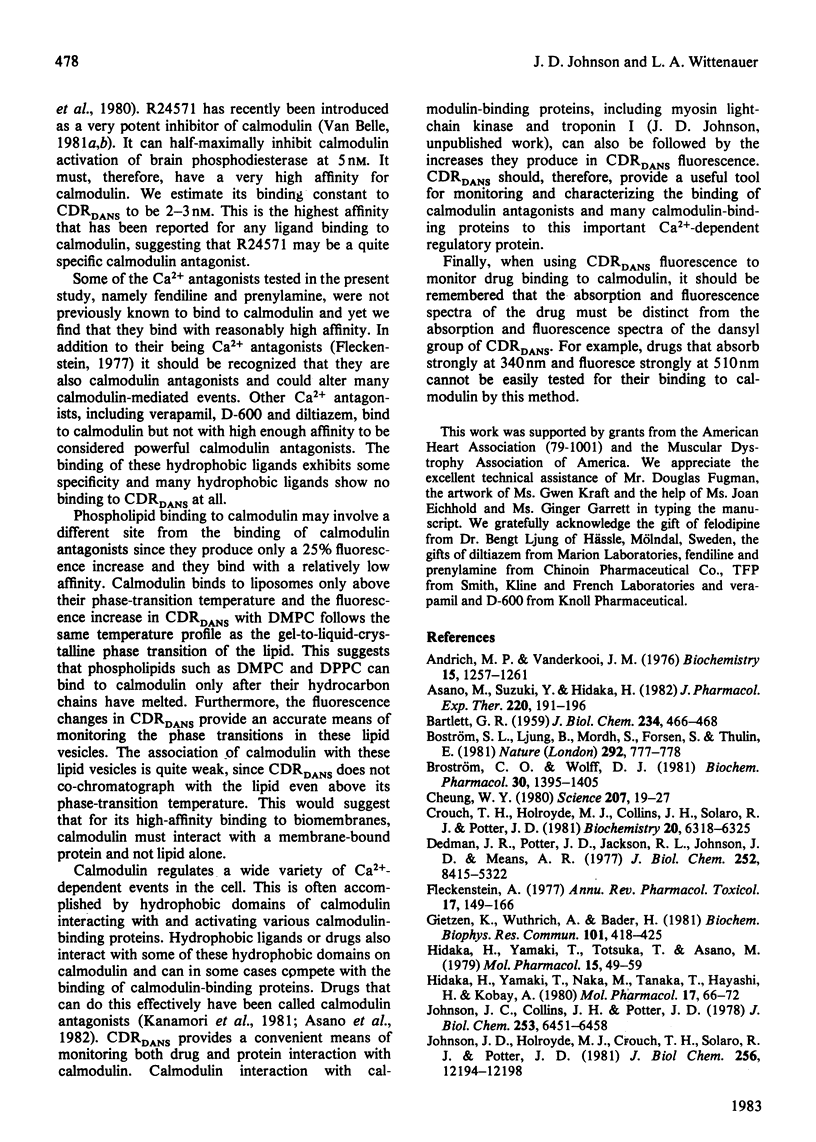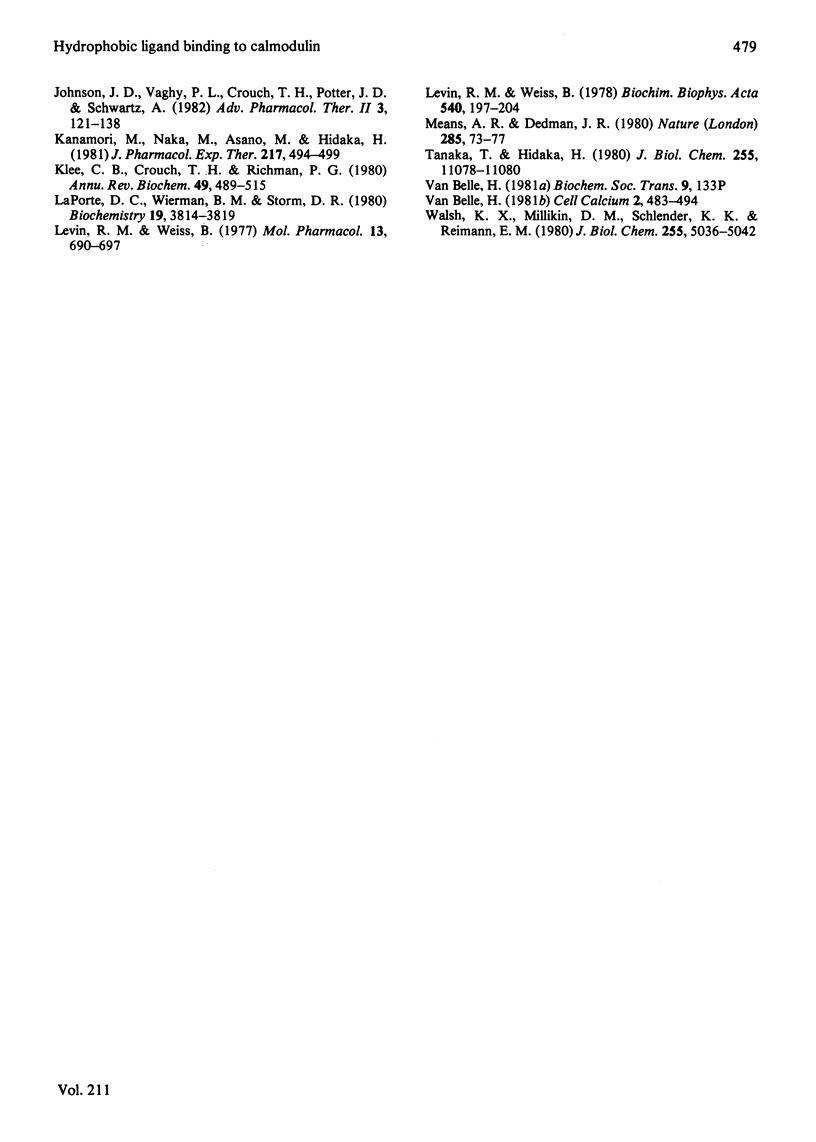Abstract
Ca2+ binding to calmodulin in the pCa range 5.5-7.0 exposes hydrophobic sites that bind hydrophobic inhibitory ligands, including calmodulin antagonists, some Ca2+-antagonists and calmodulin-binding proteins. The binding of these hydrophobic ligands to calmodulin can be followed by the approx. 80% fluorescence increase they produce in dansylated (5-dimethylaminonaphthalene-1-sulphonylated) calmodulin (CDRDANS). In the presence of Ca2+, calmodulin binds the calmodulin inhibitor, R24571, with an affinity of approx. 2-3 nM and hydrophobic ligands, including trifluoperazine (TFP), W-7 [N-(6-aminohexyl)-5-chloronaphthalene-1-sulphonamide], fendiline, felodipine and prenylamine, with affinities in the micromolar range. This binding is strongly Ca2+-dependent and Mg2+-independent. Calmodulin shows a reasonably high degree of specificity in its binding of these ligands over other ligands tested. CDRDANS, therefore, provides a convenient and simple means of monitoring the interaction of a variety of hydrophobic ligands with the Ca2+-dependent regulatory protein, calmodulin. CDRDANS binds to phospholipid vesicles made of (dimyristoyl)phosphatidylcholine (DMPC) or (dipalmitoyl)phosphatidylcholine (DPPC) and produces fluorescence increases only in the presence of Ca2+ and at temperatures above their gel-to-liquid crystalline phase transition. Although the fluorescence changes in CDRDANS accurately report phase transitions in these liposomes, its binding to these vesicles is weak. Calmodulin probably requires a high-affinity lipid-bound receptor protein for its high-affinity binding to natural membranes.
Full text
PDF






Selected References
These references are in PubMed. This may not be the complete list of references from this article.
- Andrich M. P., Vanderkooi J. M. Temperature dependence of 1,6-diphenyl-1,3,5-hexatriene fluorescence in phophoslipid artificial membranes. Biochemistry. 1976 Mar 23;15(6):1257–1261. doi: 10.1021/bi00651a013. [DOI] [PubMed] [Google Scholar]
- Asano M., Suzuki Y., Hidaka H. Effects of various calmodulin antagonists on contraction of rabbit aortic strips. J Pharmacol Exp Ther. 1982 Jan;220(1):191–196. [PubMed] [Google Scholar]
- BARTLETT G. R. Phosphorus assay in column chromatography. J Biol Chem. 1959 Mar;234(3):466–468. [PubMed] [Google Scholar]
- Bostróm S. L., Ljung B., Mårdh S., Forsen S., Thulin E. Interaction of the antihypertensive drug felodipine with calmodulin. Nature. 1981 Aug 20;292(5825):777–778. doi: 10.1038/292777a0. [DOI] [PubMed] [Google Scholar]
- Brostrom C. O., Wolff D. J. Properties and functions of calmodulin. Biochem Pharmacol. 1981 Jun 15;30(12):1395–1405. doi: 10.1016/0006-2952(81)90358-0. [DOI] [PubMed] [Google Scholar]
- Cheung W. Y. Calmodulin plays a pivotal role in cellular regulation. Science. 1980 Jan 4;207(4426):19–27. doi: 10.1126/science.6243188. [DOI] [PubMed] [Google Scholar]
- Crouch T. H., Holroyde M. J., Collins J. H., Solaro R. J., Potter J. D. Interaction of calmodulin with skeletal muscle myosin light chain kinase. Biochemistry. 1981 Oct 27;20(22):6318–6325. doi: 10.1021/bi00525a006. [DOI] [PubMed] [Google Scholar]
- Dedman J. R., Potter J. D., Jackson R. L., Johnson J. D., Means A. R. Physicochemical properties of rat testis Ca2+-dependent regulator protein of cyclic nucleotide phosphodiesterase. Relationship of Ca2+-binding, conformational changes, and phosphodiesterase activity. J Biol Chem. 1977 Dec 10;252(23):8415–8422. [PubMed] [Google Scholar]
- Fleckenstein A. Specific pharmacology of calcium in myocardium, cardiac pacemakers, and vascular smooth muscle. Annu Rev Pharmacol Toxicol. 1977;17:149–166. doi: 10.1146/annurev.pa.17.040177.001053. [DOI] [PubMed] [Google Scholar]
- Gietzen K., Wüthrich A., Bader H. R 24571: a new powerful inhibitor of red blood cell Ca++-transport ATPase and of calmodulin-regulated functions. Biochem Biophys Res Commun. 1981 Jul 30;101(2):418–425. doi: 10.1016/0006-291x(81)91276-6. [DOI] [PubMed] [Google Scholar]
- Hidaka H., Yamaki T., Naka M., Tanaka T., Hayashi H., Kobayashi R. Calcium-regulated modulator protein interacting agents inhibit smooth muscle calcium-stimulated protein kinase and ATPase. Mol Pharmacol. 1980 Jan;17(1):66–72. [PubMed] [Google Scholar]
- Hidaka H., Yamaki T., Totsuka T., Asano M. Selective inhibitors of Ca2+-binding modulator of phosphodiesterase produce vascular relaxation and inhibit actin-myosin interaction. Mol Pharmacol. 1979 Jan;15(1):49–59. [PubMed] [Google Scholar]
- Johnson J. D., Collins J. H., Potter J. D. Dansylaziridine-labeled troponin C. A fluorescent probe of Ca2+ binding to the Ca2+-specific regulatory sites. J Biol Chem. 1978 Sep 25;253(18):6451–6458. [PubMed] [Google Scholar]
- Johnson J. D., Holroyde M. J., Crouch T. H., Solaro R. J., Potter J. D. Fluorescence studies of the interaction of calmodulin with myosin light chain kinase. J Biol Chem. 1981 Dec 10;256(23):12194–12198. [PubMed] [Google Scholar]
- Kanamori M., Naka M., Asano M., Hidaka H. Effects of N-(6-aminohexyl)-5-chloro-1-naphthalenesulfonamide and other calmodulin antagonists (calmodulin interacting agents) on calcium-induced contraction of rabbit aortic strips. J Pharmacol Exp Ther. 1981 May;217(2):494–499. [PubMed] [Google Scholar]
- Klee C. B., Crouch T. H., Richman P. G. Calmodulin. Annu Rev Biochem. 1980;49:489–515. doi: 10.1146/annurev.bi.49.070180.002421. [DOI] [PubMed] [Google Scholar]
- LaPorte D. C., Wierman B. M., Storm D. R. Calcium-induced exposure of a hydrophobic surface on calmodulin. Biochemistry. 1980 Aug 5;19(16):3814–3819. doi: 10.1021/bi00557a025. [DOI] [PubMed] [Google Scholar]
- Levin R. M., Weiss B. Binding of trifluoperazine to the calcium-dependent activator of cyclic nucleotide phosphodiesterase. Mol Pharmacol. 1977 Jul;13(4):690–697. [PubMed] [Google Scholar]
- Levin R. M., Weiss B. Specificity of the binding of trifluoperazine to the calcium-dependent activator of phosphodiesterase and to a series of other calcium-binding proteins. Biochim Biophys Acta. 1978 May 3;540(2):197–204. doi: 10.1016/0304-4165(78)90132-0. [DOI] [PubMed] [Google Scholar]
- Means A. R., Dedman J. R. Calmodulin--an intracellular calcium receptor. Nature. 1980 May 8;285(5760):73–77. doi: 10.1038/285073a0. [DOI] [PubMed] [Google Scholar]
- Tanaka T., Hidaka H. Hydrophobic regions function in calmodulin-enzyme(s) interactions. J Biol Chem. 1980 Dec 10;255(23):11078–11080. [PubMed] [Google Scholar]
- Walsh K. X., Millikin D. M., Schlender K. K., Reimann E. M. Stimulation of phosphorylase b kinase by the calcium-dependent regulator. J Biol Chem. 1980 Jun 10;255(11):5036–5042. [PubMed] [Google Scholar]


